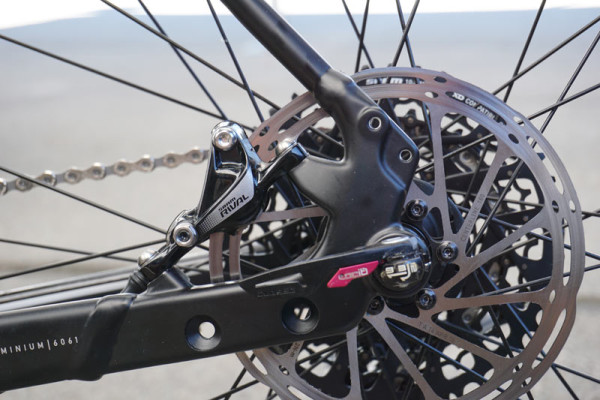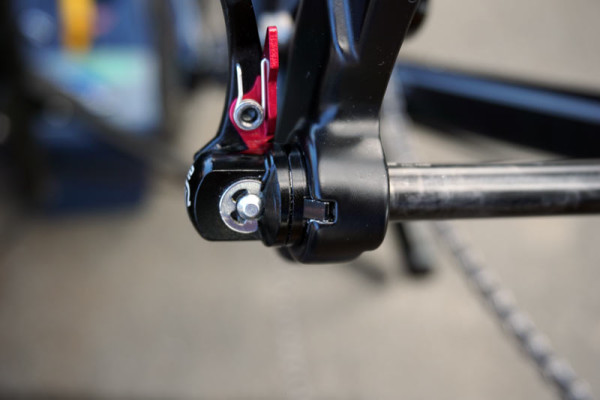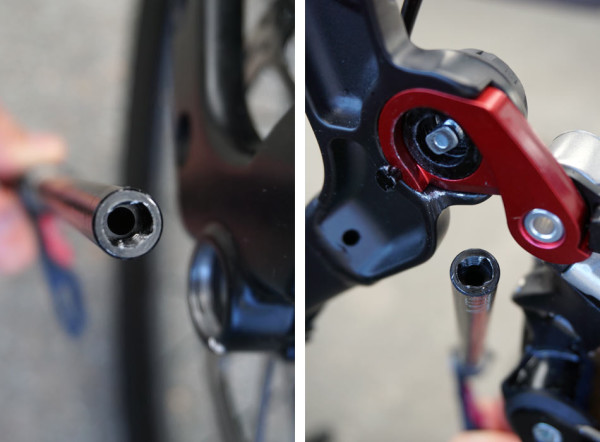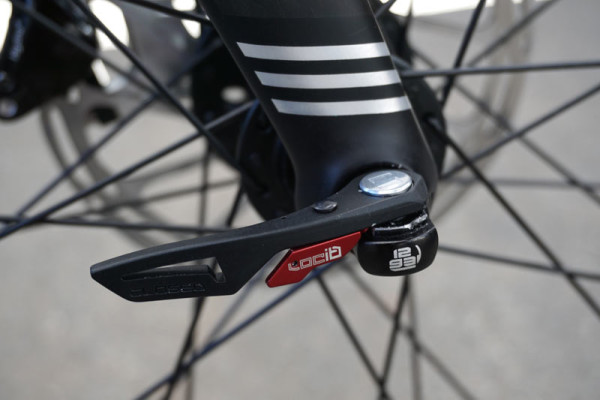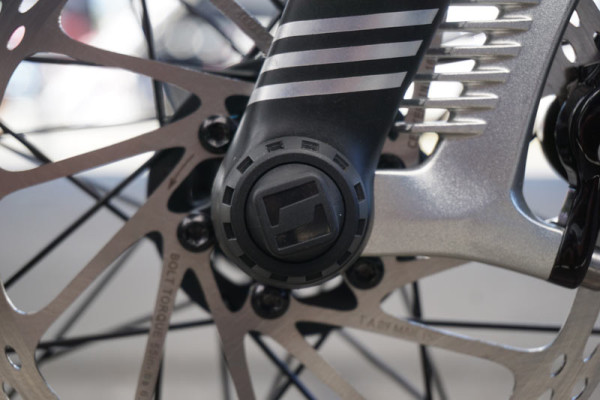Already spec’d on the 2016 Marin gravel and cyclocross bikes (post on those coming soon), the Naild locking, quick release thru axle system takes everything good about thru axles and makes them better.
The system was developed by by Darrell Voss, who worked at Klein Bikes from 1984 to 1996, then started USUL Corp in 1995 while still at Klein’s then-new owner Trek to help bring North American companies to Asian manufacturing and do U.S. service and marketing for Asian manufacturers. Since 1999, they’ve been working as a service center for SR Suntour out of Madison, WI, though Voss himself is based in Portland, OR. During that time, he helped developed Suntour’s Q-Loc thru axle, which was among the first (if not the first) thru axle that didn’t use a thread-in design to secure the wheels. In Voss’ own words, “it works pretty well.”
Fast forward to the advent of disc brakes on road and cyclocross bikes and there are new load paths on the frame structure, which got him thinking…
“Rim brakes are basically a 1:1 load force on the dropout assembly, with forces mainly going to the back of the dropout,” Voss told us. “With disc brakes, the load path on a dropout can be up to 8x higher with a 140mm rotor. And that load path is somewhat in alignment with the slot in the dropout. That’s why you’re seeing so many brands are rushing to switch to thru axles, and most of those use a threaded axle system.”
But he does admit that standard quick release dropouts do work, as long as everything’s properly installed, there’s a secondary retention device (like lawyer tabs) and the user knows what they’re doing when securing the wheel. Which is often the case when things like disc brakes were spec’d only on high end bikes purchased by experienced riders.
“As long as your current (setup) is assembled correctly with a secondary retention device, disc brakes will work fine in a standard dropout,” he says. “But these days, bikes with disc brakes are selling at all price points, even well under $1,000, so there’s a need for a very easy system that folks buying a sub-$1000 bike are able to use easily and properly 100% of the time.”
So, it comes down to safety, first and foremost.
First, a primer on how the Naild system works: The thru axle slides into the frame or fork with the lever pointing to 12 o’clock (straight up). In this position, a tab is keyed to a slot on the frame or fork to ensure it’s in the proper position. In this position, the washer behind the lever prevents the lever from closing.
The notch holds the base of the lever in position while you rotate the lever to 3 o’clock (pointing rearward on the rear wheel dropout). Once there, you can close the lever so it’s pointing to 9 o’clock.
On the frame or fork is a steel bayonet-style T-bolt. The 7000-series alloy axle is keyed to let the T-bolt slot into it in the 12 o’clock position, then as you turn it to 3 o’clock, it locks into the axle. Closing the lever pulls it all tight and secures the wheel into the frame.
Manitou and Focus Bicycles both use a similarly shaped retention mechanism for the axle, albeit reversed so that the T-shaped part is on the axle itself. The difference between those and the Naild system is that those brand’s systems allow the quick release lever to be closed regardless of whether the T-bolt is fully engaged. So, if you’re not paying attention and the axle isn’t fully inserted, you could theoretically close the lever and take off riding, only to have things get sideways real quick.
The other big difference is those brand’s allow the lever to be thrown without a secondary retention mechanism (say, during a wreck or it just comes loose…which can happen for multiple reasons). With the Naild system, there’s a secondary Locit lever that has to be depressed before the lever can be opened.
Basically, there’s no way to install this improperly, no way for it to accidentally open, and no way your wheel can come loose while riding.
“OK,” you say, “but my threaded axle from Rockshox and Fox doesn’t come loose, either.”
True, but they take time to fully thread or unthread in and out of the fork or frame, which in a road or cyclocross race can make or break the outcome. Which brings us to the next biggest benefit: Speed. Like the Manitou and Focus systems, these take all of about one second to pull out and just a couple seconds to install once you’ve got the hang of it. Yes, you’ll need to do it a couple times to practice, and then it’s easy. I messed around with it on Marin’s new bikes and had it down after five or six tries.
Voss says another benefit over competing quick-release (ie. non-threaded) systems is that the tension adjustment bezel is on the opposite side of the lever, making it less likely you’ll accidentally mess up the tension on the lever.
Perhaps the most visually distinct part of the system has nothing to do with the axle at all. Voss also designed the Navid fork, which has an integrated ICEIT (ice. it.) metal cooling fin structure. It’s not only a heat sink. Instead of standard post mounts, that finned carrier doubles as the brake mount with purpose built pieces for each rotor size – change it out to change rotor size, no need for adapters. For starters, they’re sticking with 160mm sizes only, but they’re testing heat build up in the area for 140mm rotors. Thus far, Voss isn’t convinced 140’s are appropriate for front brakes in road.
The design is done to keep the heat buildup from getting to the carbon fork legs, particularly important on the front where most of the braking power comes from. He says a lot of fork manufacturers are using a 250ºF-cure resin in their forks, so if brake heat transfers above that level to the fork, it can alter the resin structure and potentially weaken the fork.
It’s a 6000-series alloy heat sink, and he uses internal cable routing at the top. This particular fork has a tapered alloy steerer with carbon legs.
At the moment, the entire system is likely to be a forward looking solution that’s available as an OEM option for frame and fork manufacturers only, not something you can retrofit to your current bike. That’s mainly because the frame and fork need that clocking notch for the axle’s washer, and Voss makes no apologies for that. And he shouldn’t have to, because really, how often do any of us ever change the axle that comes with our bikes? So, once you have it, it’s there, and it works with any standard thru-axle hub.
For front, he’s offering 15mm and 12mm versions, and the 12mm will be spec’d on a couple of other brands later this year. These Marin bikes use the 15mm size. For rear, there’s 12×142, 12×148 Boost and 12×157 for DH, and they have fat bike widths on the drawing board.
That said, he’s focused on road bike versions for now, which makes sense considering most mountain bike forks are already using their own systems. But quick, accurate wheel changes on road and cyclocross bikes are a real point of differentiation for their system that stands to drastically benefit those riders.

